Scottish farm business income: annual estimates 2016-2017
This publication provides estimates of average farm business incomes for the accounting year 2016-17, which relates to the 2016 crop year. For the most recent data, visit the Scottish farm business income (FBI) collection page below.
7. Sector Results
7.1 Specialist Sheep (LFA) Farms – 2016 Crop Year
Profitability
When adjusting for inflation, the average FBI of specialist sheep (LFA) farms decreased by 54 per cent between 2011-12 and 2016-17. This was due to a fall in revenue from outputs and a rise in spending on livestock and labour inputs.
The FBI value of specialist sheep (LFA) farms was £14,000 in 2016-17. In the last year, an increase in outputs and a decrease in inputs for specialist sheep (LFA) farms led to FBI increasing by 71 per cent. This was also supported by an increase in the value of grants and subsidies, due to an improved exchange rate.
Drivers of profitability
The total average revenue, including income from diversification and subsidy payments for specialist sheep (LFA) farms was £89,500. Spending on inputs averaged at £75,400. The largest portion of the input costs were due to other inputs such as machinery, land and buildings costs and those related directly to livestock production (such as feed).
Losses were recorded in each of the last six years when excluding subsidy payments from the FBI calculation. There is a general downward trend, with losses increasing from £10,400 in 2011-12 to £24,900 in 2016-17.
Over the last year, cost centres for specialist sheep (LFA) farms show a decrease in losses from agricultural activities and a decrease in profits from agri-environment and contracting activities. Profits from both diversification and direct payments saw increases in 2016-17.
Return to unpaid labour
The average FBI/FTE for specialist sheep (LFA) farms was £10,500 in 2016-17, which is roughly equivalent to an hourly wage of £5.52 for unpaid labour, less than the minimum agricultural wage (MAW) in Scotland. Around 48 per cent of specialist sheep (LFA) farms generated incomes equivalent to less than the MAW, whereas 13 per cent generated more than five times MAW.
Relative performance
At £73,500, high performing specialist sheep farms generated incomes roughly five times the overall average FBI of specialist sheep farms. Low performing farm businesses made an average loss of £13,900.
Financial strength
The average net worth (assets minus liabilities) of specialist sheep (LFA) farms was £792,000 in 2016-17. The average debt ratio (liabilities: assets) was seven per cent overall and ranged between five per cent for owner-occupied farms and 13 per cent for tenanted farms.
Specialist Sheep (LFA) Farms – FBI (2016-17): £14,000
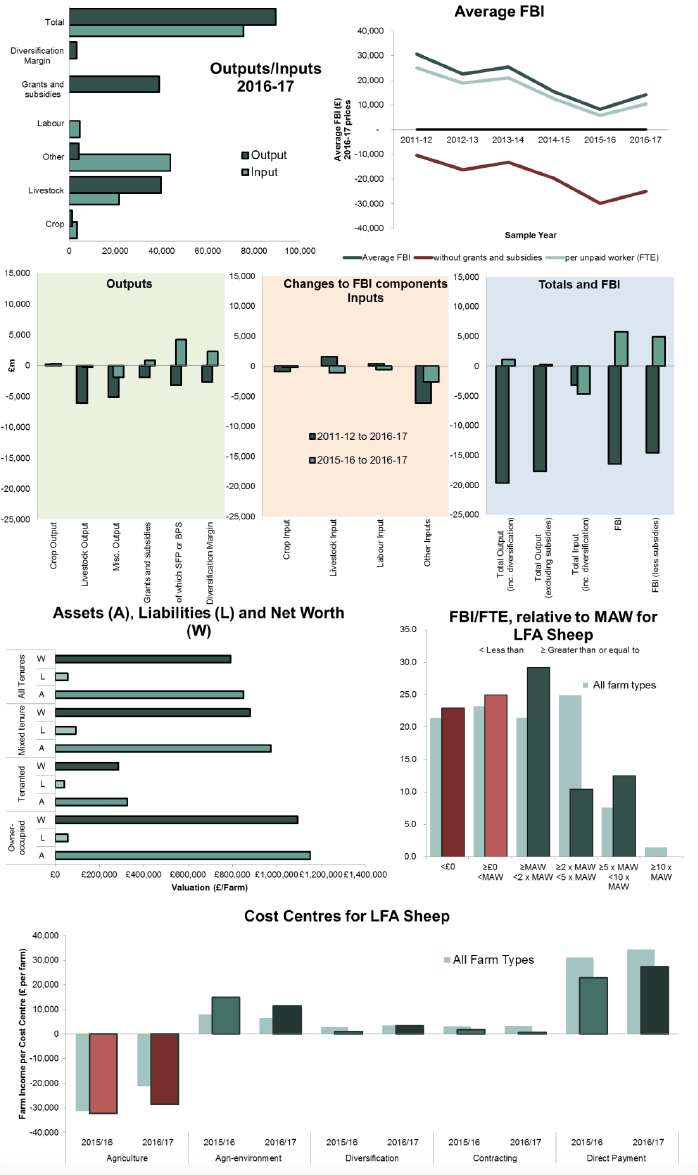
7.2 Specialist Cattle (LFA) Farms – 2016 Crop Year
Profitability
Between 2011-12 and 2016-17 the average FBI of specialist cattle (LFA) farms decreased by 44 per cent when taking into account inflation. This drop was due to a decrease in output value and a drop in grants and subsidies.
The FBI value of specialist cattle (LFA) farms was £25,600. In the last year spending on inputs as well as revenue decreased for specialist cattle (LFA) farms. However the decrease in input costs was more significant than the drop in output, resulting in an overall eight per cent rise in profits for 2016-17.
Drivers of profitability
The total average revenue, including income from diversification and subsidy payments for specialist cattle (LFA) farms was £172,800. The average spend on inputs was £147,200. The largest portion of the input costs was due to feed and other inputs such as machinery and land and buildings.
Losses were recorded in each of the last six years when excluding subsidy payments from the FBI calculation. The losses ranged from £15,800 in 2011-12 to their highest level of £31,300 in 2013-14. In 2016-17 losses of £21,100 were recorded when excluding subsidy payments from FBI.
In the last year, specialist cattle (LFA) farms had a decrease in income from all cost centres other than direct payments and agriculture. Direct payments increased by two per cent while agriculture losses narrowed by eight per cent.
Return to unpaid labour
The average FBI/FTE for specialist cattle (LFA) farms was £17,800, roughly equivalent to an hourly wage for unpaid labour of £9.34, around 30 per cent more than the minimum agricultural wage (MAW) in Scotland. Forty eight per cent of specialist cattle (LFA) farms generated incomes equivalent to less than the MAW, whereas five per cent generated more than five times MAW.
Relative performance
High performing specialist cattle (LFA) farms generated an average income of £101,000, around four times the overall average FBI of specialist cattle farms. Low performing farm businesses made an average loss of £11,000.
Financial strength
The average net worth (assets minus liabilities) of specialist cattle (LFA) farms was £1m in 2016-17. The average debt ratio (liabilities: assets) was 11 per cent for all tenures of specialist cattle (LFA) farms but ranged between ten per cent for owner-occupied and 23 per cent for tenanted farms.
Specialist Cattle (LFA) Farms– FBI (2016-17): £25,600
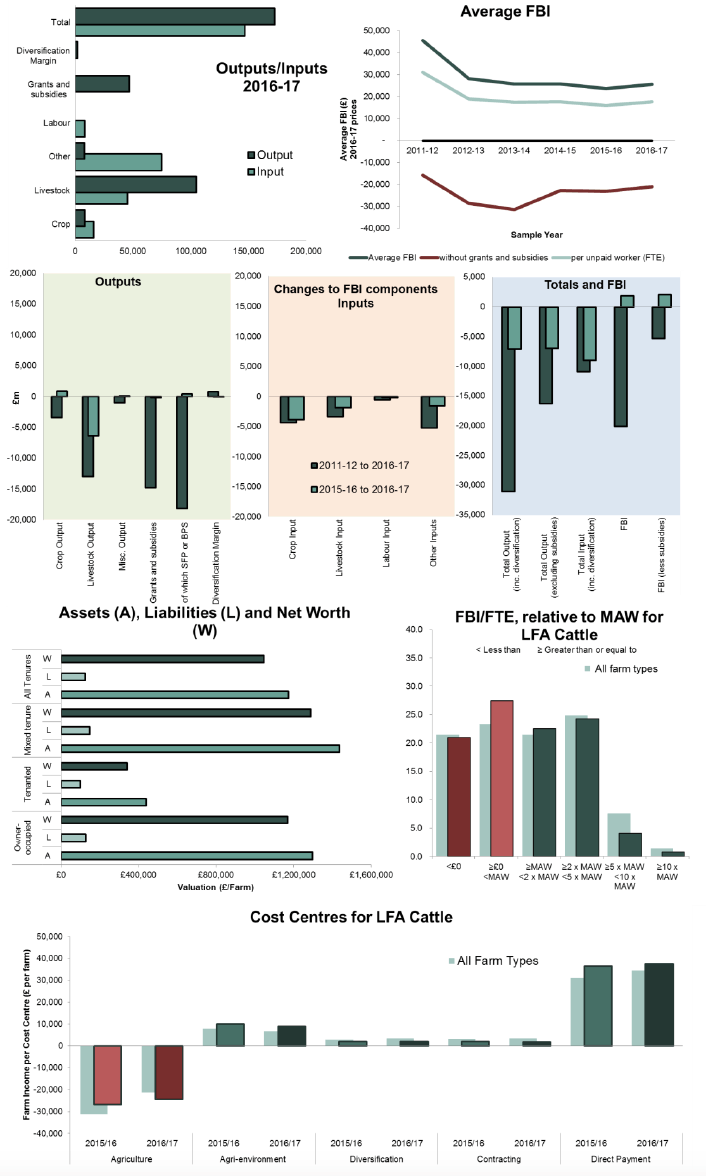
7.3 Specialist Cattle and Sheep (LFA) Farms – 2016 Crop Year
Profitability
When adjusting for inflation, the average FBI of specialist cattle and sheep (LFA) farms decreased by 17 per cent between 2011-12 and 2016-17. This decrease was mainly due to a drop in output values.
The FBI value of specialist cattle and sheep (LFA) farms was £35,300 in 2016-17. In the last year, reduced spending on inputs for specialist cattle and sheep (LFA) farms and increased revenue, notably subsidy payments and livestock outputs, led to a 54 per cent increase in the average FBI for these farms.
Drivers of profitability
The total average outputs, including income from diversification and subsidy payments for specialist cattle and sheep (LFA) farms was £175,700 and spending on inputs averaged at £140,400. The largest portion of the input costs was due to livestock costs such as feed, as well as machinery and land and buildings costs.
Over the last six years, losses were recorded in each year when excluding subsidy payments from the FBI calculation. They ranged from losses of £21,900 in 2011-12 to the highest loss of £37,900 in 2012-13. Since 2012-13, FBI without subsidy payments has seen the losses recovering to £19,600 in 2016-17.
Specialist cattle and sheep (LFA) farms have seen an increase in income from direct payments, diversification and contracting, with a decrease in losses from agriculture.
Return to unpaid labour
In 2016-17 the average FBI/FTE for specialist cattle and sheep (LFA) farms was £22,800 which was roughly equivalent to an hourly wage for unpaid labour of £11.98, 66 per cent more than the minimum agricultural wage (MAW) in Scotland. Around 23 per cent of specialist cattle and sheep (LFA) farms generated incomes equivalent to less than the MAW and seven per cent of the farms in the survey generated more than five times MAW.
Relative performance
High performing specialist cattle and sheep (LFA) farms generated average incomes of £90,700, more than two times the overall average FBI for specialist cattle and sheep farms. Low performing farm businesses made an average profit of £2,600 in 2016-17.
Financial strength
The average net worth (assets minus liabilities) of specialist cattle and sheep (LFA) farms was £1.1m in 2016-17. The average debt ratio (liabilities: assets) was 12 per cent for all tenures of LFA cattle and sheep farms but ranged between ten per cent for owner-occupied and 16 per cent for tenanted farms.
Specialist Cattle and Sheep (LFA) Farms– FBI (2016-17): £35,300
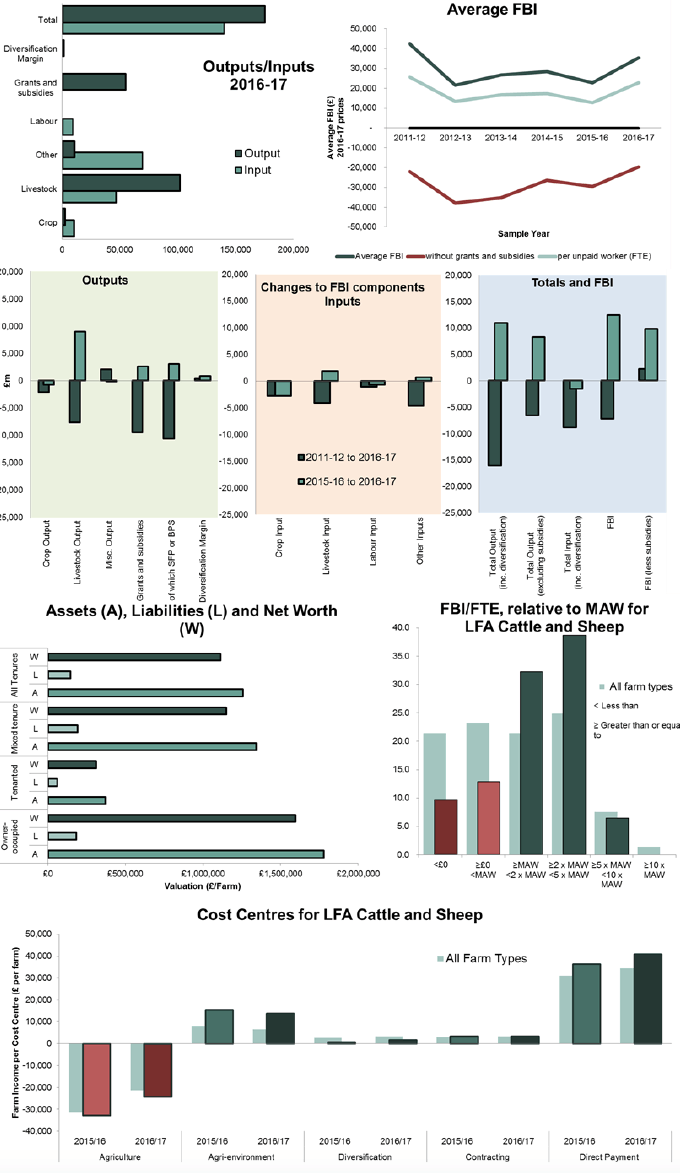
7.4 Cereal Farms – 2016 Crop Year
Profitability
When adjusting for inflation, between 2011-12 and 2016-17 the average FBI of cereal farms decreased by 64 per cent. This was due largely to the decreased value of subsidy payments and revenues from crop outputs.
In the last year, spending on inputs decreased and total output increased resulting in overall FBI rising to £20,600 in 2016-17. The increase in revenue was mainly due to an increase in the value of grants and subsidies.
Drivers of profitability
The total average revenue in 2016-17, including income from diversification and subsidy payments for cereal farms was £212,700. Spending on inputs averaged £192,100. The largest portion of the input costs was from fertilisers and other inputs such as machinery and land and buildings costs.
The range in FBI without subsidy payments over the six-year series was from a loss of £22,300 in 2012-13 to a profit of £16,900 in 2011-12. In 2016-17 the FBI without subsidy payments was a loss of £11,400.
Cost centres for cereal farms show increases in income from all cost centres apart from agri-environment, and a reduction in losses from agriculture in 2016-17.
Return to unpaid labour
The average FBI/FTE for cereal farms was £14,800 in 2016-17, which is roughly equivalent to an hourly wage for unpaid labour of £7.80, slightly above the minimum agricultural wage (MAW) in Scotland. Around 55 per cent of cereal farms generated incomes equivalent to less than the MAW, whereas nine per cent generated more than five times MAW.
Relative performance
At an average of £78,100, high performing cereal farms generated incomes roughly four times the overall average FBI for cereal farms. Low performing farm businesses made an average loss of £24,700.
Financial strength
In 2016-17, the average net worth (assets minus liabilities) of cereal farms was £1.9m. The average debt ratio (liabilities: assets) rose to 11 per cent for all tenures of cereals farms but ranged between nine per cent for mixed tenure farms and 23 per cent for tenanted farms.
Cereal Farms – FBI (2016-17): £20,600
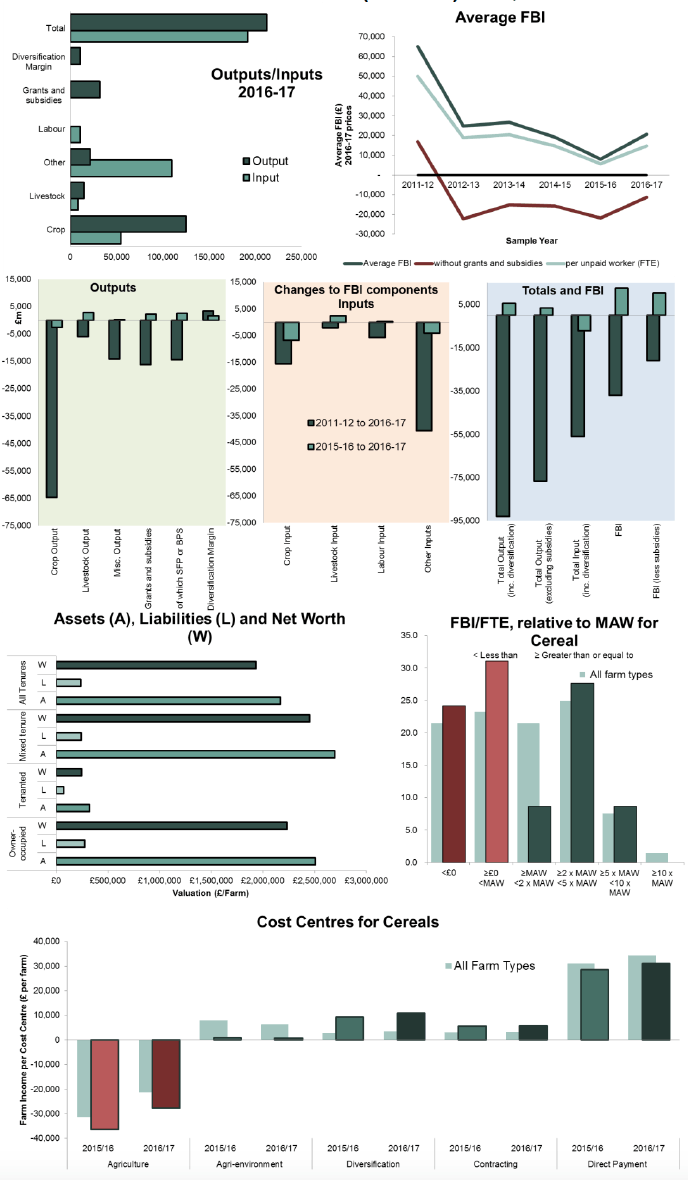
7.5 General Cropping Farms – 2016 Crop Year
Profitability
Between 2011-12 and 2016-17 the average FBI of general cropping farms decreased by 14 per cent when taking into account inflation. This was mainly due to a decrease in the revenue value of crops as well as a decrease in the value of subsidy payments.
In the last year, spending on inputs decreased by one per cent. At the same time overall output increased by five per cent. This resulted in an increase in the value of FBI for general cropping farms to £47,000.
Drivers of profitability
The total average revenue, including income from diversification and subsidy payments for general cropping farms was £280,100. Spending on inputs averaged at £233,000, with the largest portion of the input costs being machinery (including depreciation), land and buildings costs and fertilizers.
Over the last six years, FBI without subsidy payments has decreased from a high in 2012-13 with a recovery in 2015-16. 2016-17 shows an increase in FBI without subsidy, with the value rising to £11,000 from £300 in 2015-16.
In 2016-17, cost centres for general cropping farms showed decreased losses from agricultural activities and increased income from direct payments. The other cost centres all had decreased income, with agri-environment work experiencing the largest decrease of 68 per cent.
Return to unpaid labour
The average FBI/FTE for general cropping farms was £34,100 which is roughly equivalent to an hourly wage for unpaid labour of £17.96, more than twice the minimum agricultural wage (MAW) in Scotland. In 2016-17, 28 per cent of general cropping farms generated incomes equivalent to less than the MAW whereas 21 per cent generated over five times MAW.
Relative performance
High performing general cropping farms generated average incomes of £147,900, more than three times the overall average income for general cropping farms. Low performing farm businesses made an average loss of £9,300.
Financial strength
The average net worth (assets minus liabilities) of general cropping farms was £1.9m in 2016-17. The average debt ratio (liabilities: assets) was nine per cent for all tenures of general cropping farms and ranged between seven per cent for owner-occupied to 20 per cent for tenanted farms.
General Cropping Farms – FBI (2016-17): £47,000
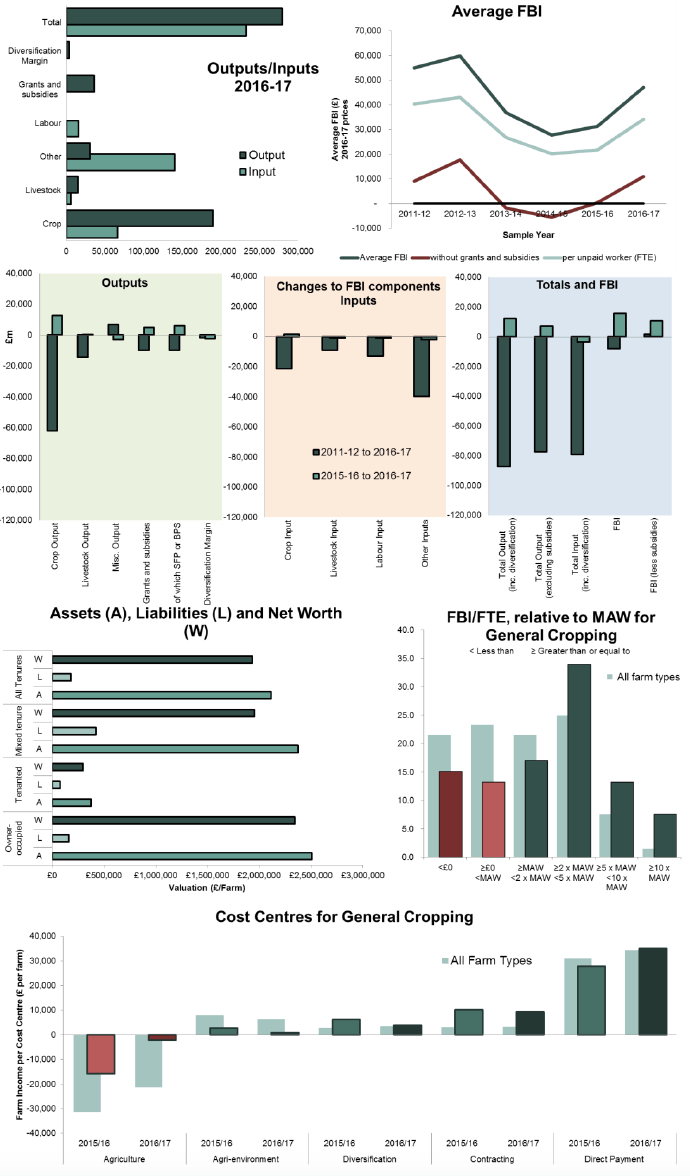
7.6 Dairy Farms – 2016 Crop Year
Profitability
When adjusting for inflation, the average FBI of dairy farms decreased by 61 per cent between 2011-12 and 2016-17. Incomes for dairy farms have fluctuated considerably over the six-year series and recovered from the lowest level in 2015-16, when the FBI value for dairy farms was £1,700, to £34,700 in 2016-17. This increase in income was due to a decrease in inputs and a recovery in the value of dairy cattle. Output remained fairly steady from the previous year due to the milk price remaining at approximately £0.21 per litre for farms in the survey.
Drivers of profitability
The total average revenue, including income from diversification and subsidy payments for dairy farms was £426,700. Spending on inputs averaged at £392,000. The largest portion of the input costs was due to livestock costs such as feed and other inputs such as machinery and land and buildings.
When looking at FBI without subsidy payments, 2016-17 saw an average loss of £600. The highest value was £43,200 in 2011-12.
Over the last year cost centres for dairy farms showed a recovery of income from agricultural activities resulting in a loss of £5,200. Diversification and direct payments had an increase in income, while income from contracting work and agri-environment decreased.
Return to unpaid labour
The average FBI/FTE for dairy farms was £16,100 in 2016-17 and is roughly equivalent to an hourly wage for unpaid labour of £8.49, 18 per cent higher than the minimum agricultural wage (MAW) in Scotland. Around 52 per cent of dairy farms generated incomes equivalent to less than the MAW whereas 14 per cent generated more than five times MAW.
Relative performance
At an average of £148,900, high performing dairy farms generated incomes around four times the overall average FBI for dairy farms. Low performing farm businesses made an average loss of £56,100.
Financial strength
The average net worth (assets minus liabilities) of dairy farms was £1.8m in 2016-17. The average debt ratio (liabilities: assets) remained constant at 14 per cent for all tenures of dairy farms. The tenant tenure type is not available for dairy farms due to small sample sizes.
Dairy Farms – FBI (2016-17): £34,700
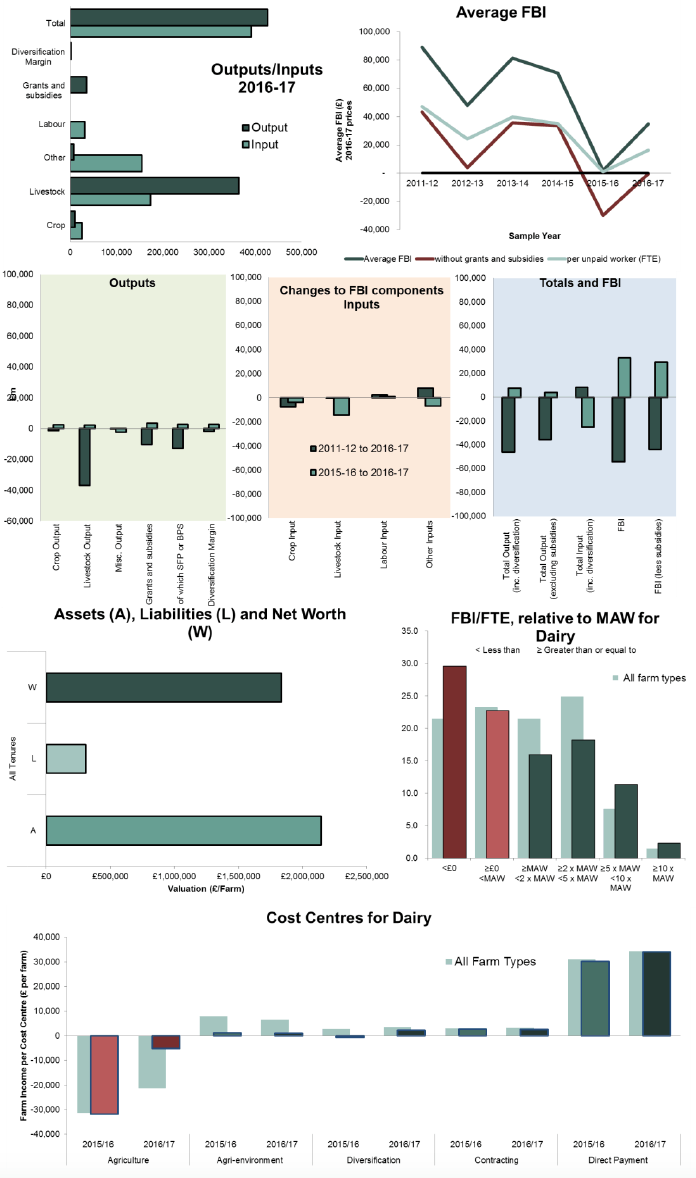
7.7 Lowland Cattle and Sheep Farms – 2016 Crop Year
Profitability
When adjusting for inflation, the average FBI of lowland cattle and sheep farms decreased by 50 per cent between 2011-12 and 2016-17. This was due to a decrease in the value of subsidy payments as well as a decrease in the revenue from crop and livestock outputs.
In the last year both spending on inputs and outputs decreased. However as the drop in inputs decreased by a larger amount, the effect had been a 47 per cent increase in the FBI value of lowland cattle and sheep farms to £18,300. The main decrease in output was a drop in livestock output.
Drivers of profitability
The total average revenue, including income from diversification and subsidy payments for lowland cattle and sheep farms was £169,300 while spending on inputs averaged at £151,000. The largest portion of the input costs was due to feed and other inputs such as machinery and land and buildings.
Over the last six years, FBI without subsidy payments has been a loss. It has ranged from a loss of £24,600 in 2012-13 to a loss of £10,400 in 2014-15. In 2016-17 the FBI without subsidy payments was a loss of £16,000.
Over the last year cost centres for lowland cattle and sheep farms showed an increase in income from direct payments and contracting activities. Agri-environment and diversification had a decrease in income and agricultural activities had a decrease in losses.
Return to unpaid labour
The average FBI/FTE for lowland cattle and sheep farms of £11,600 in 2016-17 is roughly equivalent to an hourly wage for unpaid labour of £6.12, 15 per cent lower than the minimum agricultural wage (MAW) for Scotland. Around 55 per cent of lowland cattle and sheep farms generated incomes equivalent to less than the MAW whereas four per cent generated more than five times MAW.
Relative performance
High performing lowland cattle and sheep farms generated average incomes of £64,000, roughly four times the overall average FBI for lowland cattle and sheep farms. Low performing farm businesses made an average loss of £9,900.
Financial strength
The average net worth (assets minus liabilities) of lowland cattle and sheep farms was £1.2m in 2016-17. The average debt ratio (liabilities: assets) rose one percentage point to nine per cent for all tenures of lowland cattle and sheep farms and ranged between eight per cent for owner-occupied to 20 per cent for tenanted farms.
Lowland Cattle and Sheep Farms – FBI (2016-17): £18,300
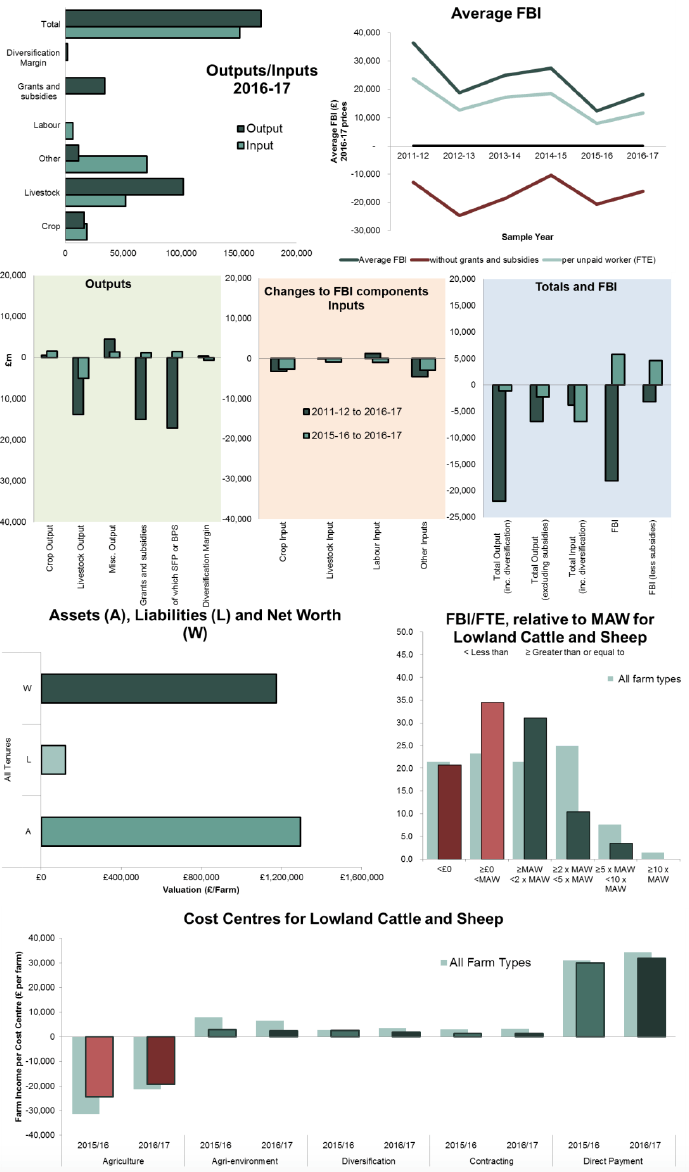
7.8 Mixed Farms – 2016 Crop Year
Profitability
Between 2011-12 and 2016-17, the average FBI of mixed farms decreased by 55 per cent, when inflation was taken into account. This decrease was due to a reduction in the value of subsidy payments and revenues from crop and livestock outputs.
In the last year, an increase in revenue resulted in the FBI value of mixed farms rising to £24,200. The increase in revenue was due to growth in crop and livestock outputs, coupled with an increase in the value of subsidy payments.
Drivers of profitability
The total average revenue, including income from diversification and subsidy payments for mixed farms was £231,000. Spending on inputs averaged at £206,900. The largest portion of the input costs was due to spending on machinery (including depreciation), feed and land and buildings.
Over the last six years, FBI without subsidy payments has been on a declining trend, with losses recorded in each year. 2015-16 recorded the biggest loss of £34,400 while 2016-17 recovered slightly to a loss of £16,400.
Over the last year cost centres for mixed farms showed increased income as part of direct payments, agri-environment and contracting activities. Diversification recorded a decline in income, while losses from agricultural activities decrease.
Return to unpaid labour
The average FBI/FTE for mixed farms was £16,200 in 2016-17 which is equivalent to an hourly wage for unpaid labour of £8.54, 19 per cent higher than the minimum agricultural wage (MAW) in Scotland. Around 50 per cent of mixed farms generated incomes equivalent to less than the MAW, whereas seven per cent generated over five times MAW.
Relative performance
At £74,200, on average, high performing mixed farms generated incomes roughly three times the overall average FBI for mixed farm types. Low performing farm businesses made an average loss of £17,000.
Financial strength
The average net worth (assets minus liabilities) of mixed farms was £1.7m in 2016-17. The average debt ratio (liabilities: assets) fell to ten per cent for all tenures of mixed farms but ranged between eight per cent for owner-occupied farms and 19 per cent for tenanted farms.
Mixed Farms – FBI (2016-17): £24,200
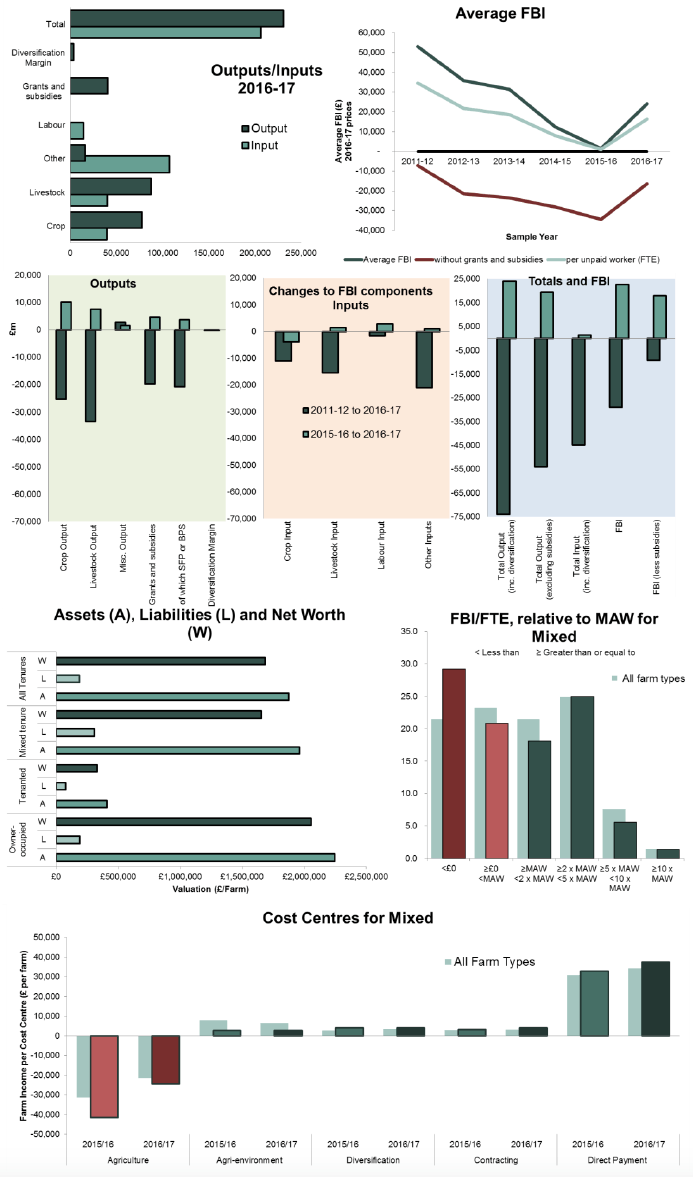
Contact
There is a problem
Thanks for your feedback